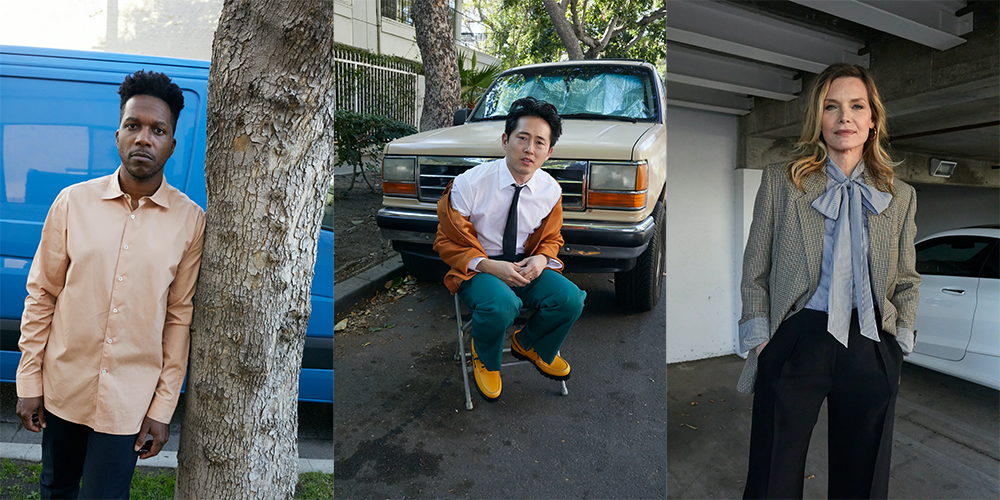Juergen Teller's W Magazine Photos ARE the Point
The concept of celebrity has never been less relevant. Juergen Teller's latest Best Performances portfolio understands that.
While being flung around by the ceaseless tornado that is our hyper-technologized, meme-a-minute world, it seems that it has become impossible to nail down exactly what we want from…anything. When it comes to the world of glamour and luxury depicted in fashion magazines, we’re even more unsure. One side wants to continue luxuriating in the decadence of these impossible worlds, the other vocal in their detest of those very impossibilities and the systems they perpetuate. And then there are the ones in the middle that don’t really care either way and are only here for the alluring chance to go viral — punchlines and popularity held in equal reverence.
The newest punching bag is W Magazine, which debuted a slew of covers for its annual Best Performances issue this week. Photographed by Juergen Teller, the covers were ripped apart online for their seemingly pedestrian nature. Teller shot some of the most notable actors in the industry propped up against cars, leaning against trees, and standing casually on the sidewalks of LA. “juergen teller is going to hell for this,” read one tweet. “juergen teller is a photographic terrorist,” read another. Others collected old, candid paparazzi photographs of celebrities and meme’d them as sendups of the editorial.
My initial reaction to this discourse was simply this: I’m tired. I’m tired because I feel like we’ve been doing this forever. On Twitter, everyone thinks they’re an expert. And though I’m simply a fashion school dropout myself, I tend to dislike when something can be disproven by a cursory google search, like when Y*shar *li claimed that Anna Wintour ran with an unapproved photograph for Vogue’s Kamala Harris cover last month — something that anyone with even a peripheral knowledge of how the magazine operates knows would never happen, even for a publication with a past as troubling as Vogue’s. This isn’t the first time that Juergen Teller has been criticized for his work, let alone his work for W’s Best Performances issue. The problem is not, as some have claimed, that people are missing the point – it’s that the point is so self-evident, and yet no one has taken one second to think semi-critically about it or familiarize themselves with Teller’s other work, specifically his work for W and the concept behind it that began in 2013, when the first of his Best Performances portfolios was published in the magazine’s February issue.
“I had been thinking it was time for a bit of a glamour backlash,” wrote [former W Editor-in-Chief] Stefano Tonchi in his February editor’s letter. Enter artist and photographer Juergen Teller, whom Tonchi and Editor-at-Large Lynn Hirschberg tasked with capturing 33 of this year’s most celebrated actors in his signature raw and largely un-retouched style. “I will kidnap the actor or actress and go to an undisclosed location, where we will take pictures for a few hours without any editor, publicist, or hair and makeup artist on set,” Teller warned before the shoot. And that he did. - W Magazine, February 2013
By dimming a stars’ mega-wattage, Teller is doing what he has done his entire career: placing celebrities and models into settings that seem almost nonsensical given the nature of their occupation. To complain about the photos looking amateurish is to hit the point smack dab in the face. W’s Best Performances issue initially started out as a glamorous annual compilation of both seasoned and emerging stars, with its first two layouts in the February 2011 and 2012 issues being shot by Inez & Vinoodh and Mario Sorrenti, respectively. In the years following, the publication has sometimes made it more of an exercise in irony, especially when working with Teller. These actors have been booked for the issue because of their memorable onscreen portrayals, but Teller’s photographs put them back down to earth for their most demanding performance yet: a real person — anyone on the street, looking like they were stopped by a street fashion photographer circa Blogspot 2009.
But it’s not just W’s Best Performances issue or the style of the photographs themselves that come under fire, it’s often Teller’s ability and position in the industry that receives the brunt of the criticisms. I don’t think it’s exactly unfair to say that a lot of young people on Twitter, primarily the accounts with celebrity avatars that shield faceless Gen Z stans, probably aren’t that familiar with the breadth of Juergen Teller’s photography.
Teller — largely known for his washed-out film photographs and campaigns for big fashion houses like Marc Jacobs, Céline, and Coach — has always had a flair for clashing the iconic with the ironic. Despite what the average meme-maker on Twitter might say, Teller’s photographs always have a distinct style, whether they’re shot on film or digital. Juergen Teller loves an outdoor shot. He loves using flash. He loves making unnatural things look natural and vice versa. His photos are unretouched, tongue-in-cheek, and blithely aware of their high glamour, high profile, high fashion subjects. Many of them are rightfully revered for being quintessential pieces.
Joan Didion by Juergen Teller for Céline, 2015
W had every opportunity to commission a different photographer for this issue, one who might photograph the celebrities featured in their Best Performances edition with a light of cinematic glamour. Their 2015 and 2019 editions, photographed by Tim Walker, saw celebs portrayed as fantastical, waifish versions of themselves, in line with Walker’s signature style. But I theorize that W commissioned Juergen Teller for his fifth Best Performances editorial for two very important reasons:
A huge cultural talking point is a major step for W’s rebirth and successful existence.
Celebrity, as a concept, has never been less relevant to the everyday person.
Even in its most dire states, W has remained committed to lofty fashion editorials and ambitions as large as the oversized measurements of their publication. With little visible effort to minimize the magazine’s huge overhead, those aspirations may be part of why W has been struggling with consistent funding for years. As the second-rank high fashion book at Condé Nast — under the publisher’s crown jewel Vogue — W Magazine’s expensive pages eventually became more and more difficult to hold onto while the print industry sought new revenue streams by pushing their digital side. Condé Nast eventually had to decide between selling off one of its luxury-based titles or continuing to hemorrhage money in an environment evolving too fast for them to keep up with. In 2019, the company sold off W Magazine to Future Media for an undisclosed figure (estimated as $7 million by the Post).
Only nine months later, the pandemic rocked the industry once more, and Future Media furloughed a large percentage of W’s staff, with employees on the digital side staying on and the magazine’s print side being shuttered indefinitely. Last August, W was acquired by Bustle Digital Group and entrusted with millions from high-profile investors like Kaia Gerber, Karlie Kloss, and Jason Blum. With a joint-effort being made in the months following to push W’s digital position significantly as they return to churning out six print issues a year, the magazine’s annual Best Performances issue — which always elicits both commendation and criticism — is the perfect way to draw some hype.
Ad revenue is a numbers game. A title can try to convince brands to trust their money with a publication by editorial content alone, but it’s a hard sell, especially when audiences in 2021 move on much faster from something beautiful than something more conventional but still captivating. Advertisers want a return on their investment, and that means getting a lot of eyes (and clicks) on what is likely W’s most expensive issue to produce each year. How to make that happen without taking out a huge overhead advertising cost? Free publicity.
Enter Teller. His last Best Performances spread was just last year, in 2020. Among others, he photographed Adam Sandler with a shopping cart, Florence Pugh holding some plates, Elle Fanning in a tanning bed, and many, many people in parking lots. But this year, a photographer famous for his attempts to capture celebrities’ idiosyncrasies through flash-heavy, deadpan portraiture, stripped it down even more. Teller’s subjects have never looked quite so…uncomfortable? So out of place in their own photographs? So…out of touch.
Leslie Odom Jr., Steven Yeun, and Michelle Pfeiffer photographed by Juergen Teller for W Magazine, 2021.
There lies the point. Sorry to deliver it to you so plainly, but it’s true. Teller’s work for W has always been focused on seeing another side of celebrity, not necessarily the kind that portrays them as “just like us,” but almost criticizing their celebrity status through the washed-out absurdity of his photographs. It has been less than a year since Gal Gadot’s moronic, bafflingly tone-deaf celebrity singalong of “Imagine,” and now Teller has propped her up against a Jeep wearing two ugly dresses and some kitten heels to shoot her for her “great performance” in Wonder Woman 1984. Stand Jared Leto and Tessa Thompson against a tree. Put Jonathan Majors in a tree. Photograph Michelle Pfeiffer in a parking garage! Make James Corden sit in a road verge on a little chair and look uncomfortable!!! There’s a pandemic, people are dying every day, people are losing their homes and their family and their loved ones, and don’t know when they’ll be able to pay their bills. There has never been any moment where the concept of celebrity — a rich, famous, glamorous, and powerful person — has been less relevant and less interesting. Juergen Teller’s photos speak precisely to that. He’s not interested in making this a glamorous affair, and neither is W magazine, which is precisely why they brought him back for another year. Both W and Teller knew the exact reaction these pictures would elicit, and the internet gave it out in droves.
Besides the amount of (very funny) memes, there has also been a collection of complaints. A lot of “I could do this with a Samsung and a chair.” And you could! I could! That’s exactly it. This isn’t Teller shooting on film, in a studio, with props and two cameras snapping away at once, these are amateurs. Teller’s photographs serve as an established artist reminding others that the playing field is being leveled and that it will continue. There has never, ever been a moment in pop culture quite like the one we’re currently facing, when the power dynamics can shift so quickly. The era of fashion magazine gatekeeping is crumbling, and rightfully so. Longstanding publications are folding, editors are stepping down to make way for new, diverse talent, and others are being held accountable to their commitments to do the same. And it’s not just the magazines, but the subjects on their covers and the people behind the cameras. The celebrities could be anyone. Jacob Eldori squatting by a tree is no better than anyone else, and neither is the guy who took the photograph. That’s the Best Performance of them all: the rich and famous as any more deified than you or I.
[This article was originally published at Top Shelf, Low Brow].





